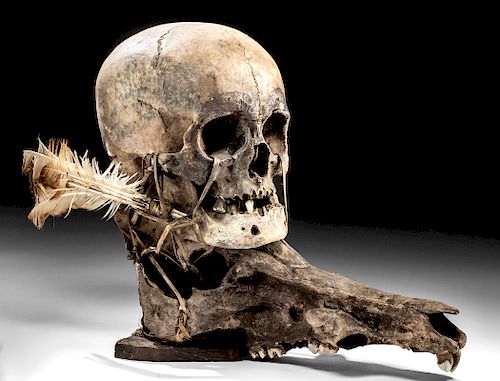19th C. Ifugao Human Trophy Skull w/ Boar Skull
Lot 61b
About Seller
Artemis Fine Arts
686 S Taylor Ave, Ste 106
Louisville, CO 80027
United States
Selling antiquities, ancient and ethnographic art online since 1993, Artemis Gallery specializes in Classical Antiquities (Egyptian, Greek, Roman, Near Eastern), Asian, Pre-Columbian, African / Tribal / Oceanographic art. Our extensive inventory includes pottery, stone, metal, wood, glass and textil...Read more
Categories
Estimate:
$5,000 - $7,500
Absentee vs Live bid
Two ways to bid:
- Leave a max absentee bid and the platform will bid on your behalf up to your maximum bid during the live auction.
- Bid live during the auction and your bids will be submitted real-time to the auctioneer.
Bid Increments
| Price | Bid Increment |
|---|---|
| $0 | $25 |
| $300 | $50 |
| $1,000 | $100 |
| $2,000 | $250 |
| $5,000 | $500 |
| $10,000 | $1,000 |
| $20,000 | $2,500 |
| $50,000 | $5,000 |
| $100,000 | $10,000 |
| $200,000 | $20,000 |
About Auction
By Artemis Fine Arts
Oct 3, 2019
Set Reminder
2019-10-03 10:00:00
2019-10-03 10:00:00
America/New_York
Bidsquare
Bidsquare : Exceptional Day 2: Pre-Columbian & Tribal Art
https://www.bidsquare.com/auctions/artemis-gallery/exceptional-day-2-pre-columbian-tribal-art-4453
Day 2 of an important 2-day auction featuring exceptional, museum-worthy examples of Pre-Columbian from the ancient Americas, Native American, African / Tribal, Oceanic, Spanish Colonial and fossils. Artemis Fine Arts info@artemisgallery.com
Day 2 of an important 2-day auction featuring exceptional, museum-worthy examples of Pre-Columbian from the ancient Americas, Native American, African / Tribal, Oceanic, Spanish Colonial and fossils. Artemis Fine Arts info@artemisgallery.com
- Lot Description
Southeast Asia, northern Philippines, Ifugao province, ca. 19th century CE. A fascinating artifact from the native people of the island of Ifugao, who prior to contact with the western world - which mainly occurred during the American occupation of the island during WWII - practiced traditional headhunting. This is a trophy human skull mounted on a boar skull, lashed together using rattan. The boar skull is attached to a wooden platform for display in ceremonies and on buildings. Water-based pigments are on the human skull, most notably in a thick border around the eye sockets, and the chin has been drilled through in two places. Size: 14" W x 10.8" H (35.6 cm x 27.4 cm)
Headhunting - taking a skull and preserving it after killing someone - was practiced around the world throughout history, from Oceania to Europe and Mesoamerica. Anthropologists became intensely interested in the practice, especially in the early to mid 20th century, and developed a general theory about the meaning of headhunting: to define hierarchy and power within communities, based on the idea that the head contained the life force of the individual, and that capturing it allowed its holder to contain that power. For the Ifugao, the taken head was a prized object. The Ifugao mounted heads like this one over their hearths and outside their huts.
See David Howard, "The Last Filipino Head Hunters", 2001, p. 35.
Provenance: private San Francisco, California, USA collection
All items legal to buy/sell under U.S. Statute covering cultural patrimony Code 2600, CHAPTER 14, and are guaranteed to be as described or your money back.
A Certificate of Authenticity will accompany all winning bids.
We ship worldwide and handle all shipping in-house for your convenience.
#148655Both skulls have been modified for display with some painting, drilling, removal of small components. The lower jaw of the boar has been deliberately excluded. Rich patina on all surfaces. Rattan is in nice condition for its age and the skull is secure in its position.Condition
- Shipping Info
-
All shipping is handled in-house for your convenience. Your invoice from Artemis Gallery will include shipping calculation instructions. If in doubt, please inquire BEFORE bidding for estimated shipping costs for individual items.
-
- Buyer's Premium



 EUR
EUR CAD
CAD AUD
AUD GBP
GBP MXN
MXN HKD
HKD CNY
CNY MYR
MYR SEK
SEK SGD
SGD CHF
CHF THB
THB














